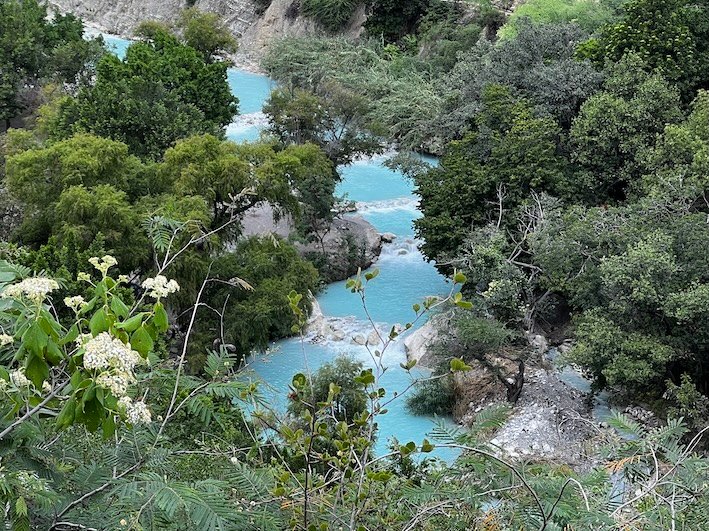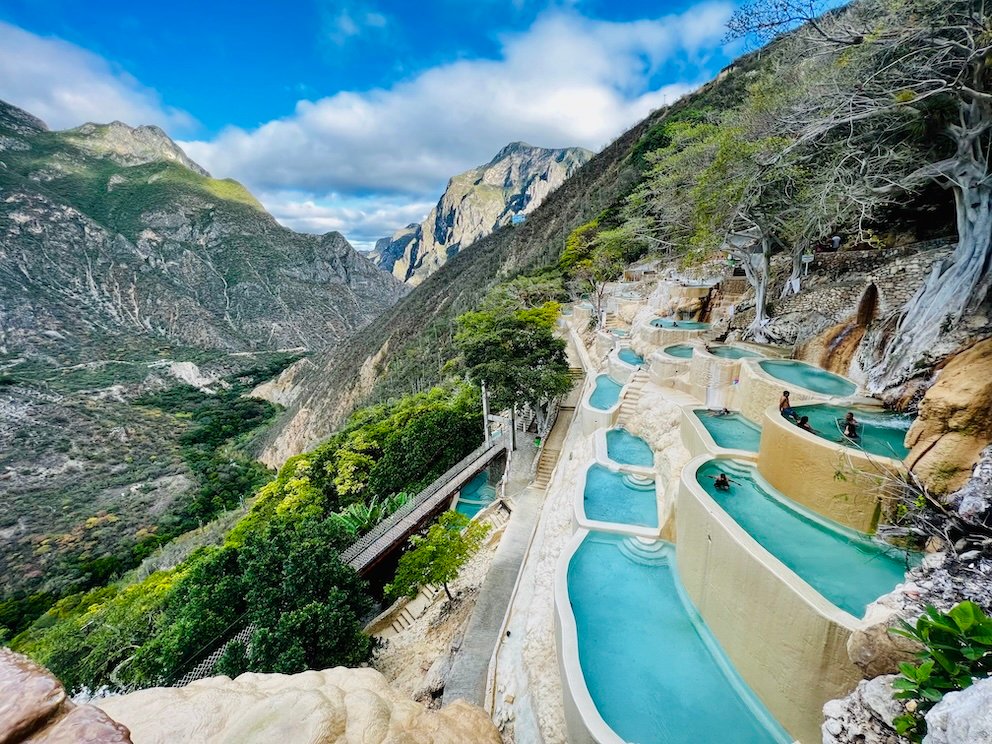I first saw a photo of Grutas Tolantogo on a suggested post on social media – damn those algorithms really know what I would like: dreamy baby blue pools of water overlooking a thermal river of the same azure hue. As soon as I saw the photo – I knew I had to go. Roughly a year later – here I was – and wow – this place did not disappoint. Tucked away in the lush mountains of the state of Hidalgo, Grutas Tolantongo is one of Mexico’s finest hidden gems. A river of aquamarine blue hot spring water meandering through a valley surrounded by mountains that look like something out of a James Cameron dreamscape. Cascading thermal waterfalls feeding into glowing blue pools; caves that doubled as secret hot springs sauna spots – this was one of the most magical places I’ve visited in the world! This blog post is a comprehensive guide on how to get to Grutas Tolantongo and how to make the most of your time there.
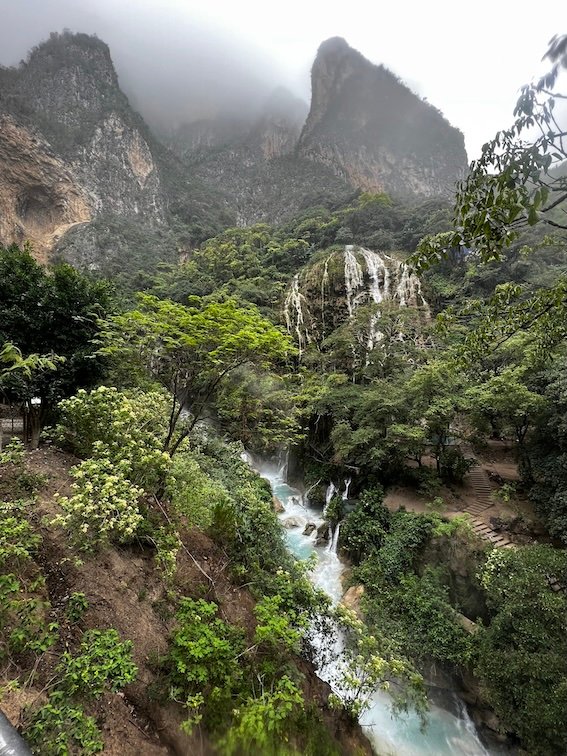
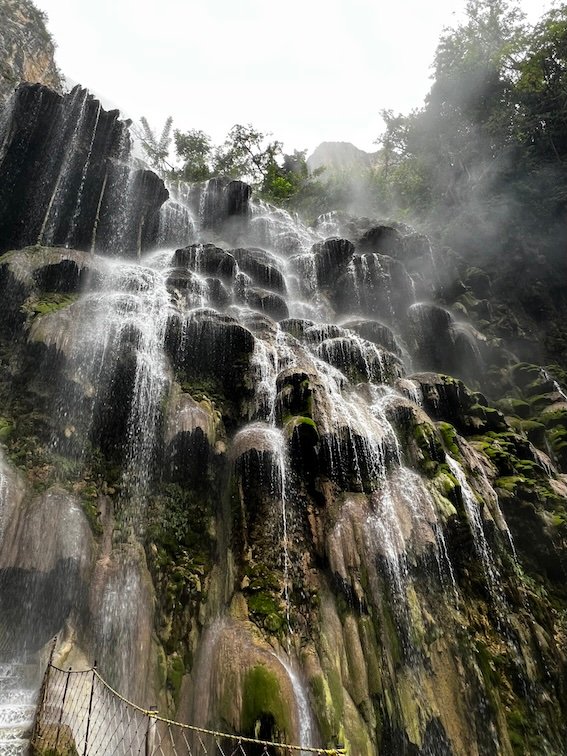
Content:
- General Information
- How to Get to Grutas Tolantongo
- When to go
- Where to stay
- Camping
- Restaurants and Shops
- Recommended Packing List
- Additional Packing List if Camping
- Final Thoughts on Grutas Tolantongo
This post includes affiliate links. If you make a purchase via one of these links, I may receive a small percentage at no extra cost to you.
General Information:
Grutas Tolantongo is recreational park area centered on the shores of a natural thermal river which also links to a natural cave and thermal waterfall system. Entry into the park requires a 230MXN fee calculated per day. There is actually a second park area over a suspension bridge to the other side of the river called “La Gloria Tolantongo” which has its own hotel and camping area, requires an additional 150MXN fee to enter. Note that you’ll be asked for the fee as soon as you cross the suspension bridge so do not cross unless you want to spend time on the other side. Note that this post will focus on the “Gruta Tolantongo” park as I did not visit “La Gloria Tolantongo” park during my trip.
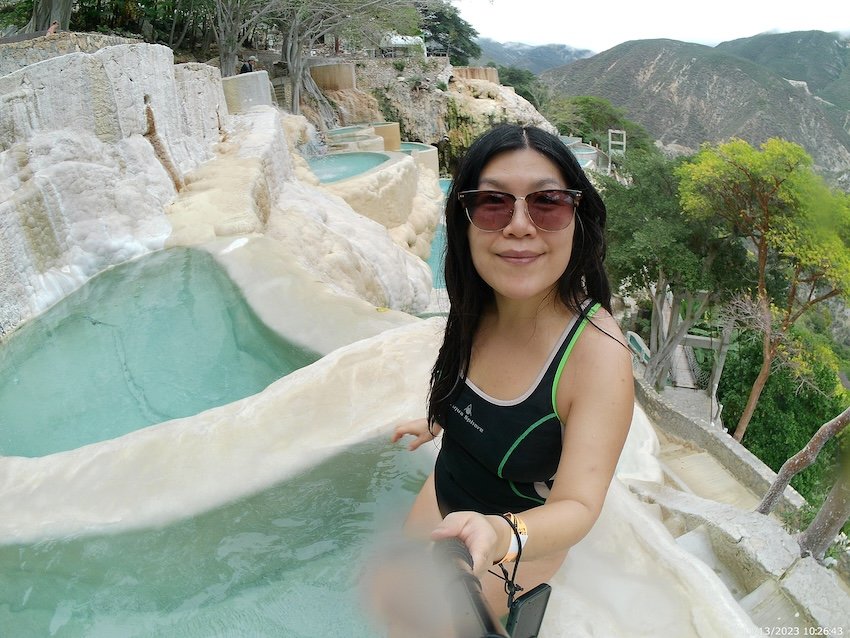
Grutas Tolantongo are divided into the “Grutas” (caves) section of the park – which is closest to the main parking lot, and the “Paraiso Escondido” (Hidden Paradise) section of the park – which is situated away from the riverside, but is where the “Pocitas” or “Pozos Thermals” (Thermal Pools) section of the park is located. The “Grutas” section of the park has both hotels and riverside camping – along with full-service camping rentals, restaurants, shops and is the most assessible section of the park due to its proximity to the main parking lot.
The “Pozos Thermals” section of Tolantongo is likely the photo that drew you to Tolantongo in the first place. Terraced aquamarine thermal pools cascading down the side of a mountain…it’s a photographic siren call that says “come float in a real-life dreamscape”.
The thermal pools section of Grutas has its own park-run hotel “Hotel Paraiso”, as well as camping – but note that the camping is not river-side like it is in the Grutas section of the park. I would recommend camping in the “Grutas” section of the park rather than the “Paraiso” section of the park – in order to be by the river if you plan to camp.
How to get to Grutas Tolantongo:
By yourself:
The major transport hub to getting to Grutas Tolantongo is via the town of Ixmiquilpan (located about a 3 hour bus ride from Mexico City). You may also reach the town via other towns and cities in Mexico; but Mexico City would be the largest hub from which to get to Ixmiquilpan.
Buses to Ixmiquilpan leave regularly from Mexico City’s North Terminal. The bus ride was pleasant, and most large buses will have on-board washrooms. Please ensure to bring your passport – this is especially important if you do not purchase your tickets online – as they will not sell you a ticket at the bus stations without your passport. Foreign government-issued drivers license will not suffice – I saw Mexican-Americans denied bus ticket purchases because they did not have their passports with them. As an aside, I inwardly laughed a little when the ticket-seller pointed at me when the Mexicans-Americans complained that they did not know they needed their passports and said “Look, the Gringa had HER passport”. As a general rule, if you’re crossing state lines on a bus in Mexico it is best to carry your passport. I recommend buying tickets in advance online especially if you’re not comfortable speaking Spanish. I was told I was only allowed to pay by cash (sketchy) at Mexico City’s North Terminal – and almost got short changed 50% the cost of the bus ticket, thankfully managed to talk to the ticket agent (in Spanish) and she gave me back the right change.
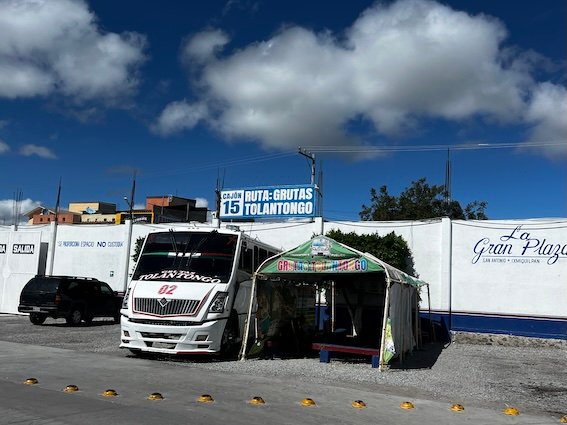
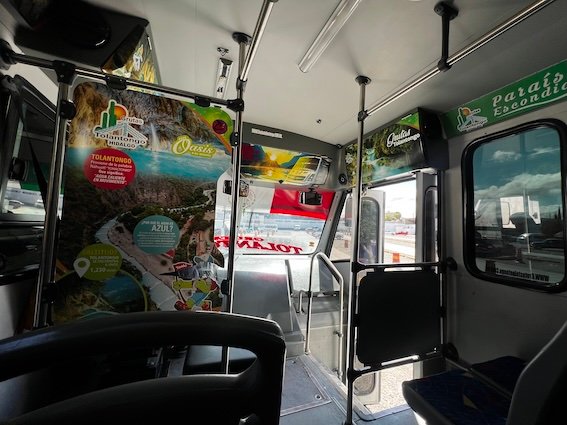
If going by bus, note that the Collectivo Station to get the bus to Grutas Tolantongo is about 1.5KM away from the main bus station in Ixmiquilpan. You can either walk the distance, or there are plenty of taxis outside of the bus station to take you the short distance (just remember to set a price before you agree to the ride). A taxi ride this short should not cost you more than 50MXN, but you might agree to pay a “premium” if you have a lot of luggage. Overall, I would recommend travelling lightly (just a backpack) and just walking the short distance if you’re able to – I would generally avoid bringing bulky luggage even if you plan to stay at one of the hotels at Grutas Tolantongo, as there are quite a few stairs to climb and they may not always have accessible ramps to roll your luggage up.
The Collectivo from Ixmiquilpan leaves from its own stand at the Collectivo Station across the street from the San Augustin Church. I’ve noted the approximate location of the collectivo bus stop on the map – if you find yourself lost, just find the San Augustin Church, and then ask around. The entrance to the collectivo station is a bit hidden away, but once you find the entrance, you’re going to wonder how you missed it because it’s actually huge – with a large number of collectivos going to a great number of different places. The Collectivo itself is actually a large bus driven by a highly skilled stunt car driver who weaved this behemoth 40 passenger bus through faint-inducing hair-pin turns on a gravelly mountain road. Just the collectivo ride from Ixpalin to Tolango was already worth the 70 Peso adventure.
On a tour:
If the idea of trying to get to Grutas Tolantongo by yourself seems too daunting, consider going on a tour – which takes care of the hard work of navigating to this magical – but admittedly out-of-the-way place for you. This tour comes highly recommended and is also one of the most affordable and well-reviewed options available that includes round-trip transportation from Mexico City as well as a guided tour.
When to go:
November to May (with the exception of the week before Easter “Semana Santa”) is generally considered an ideal time to visit. The weather is cool and dry, and you can avoid the crowds that can accumulate in December and January. If you want tranquility, avoid coming on weekends and Mexican holidays.
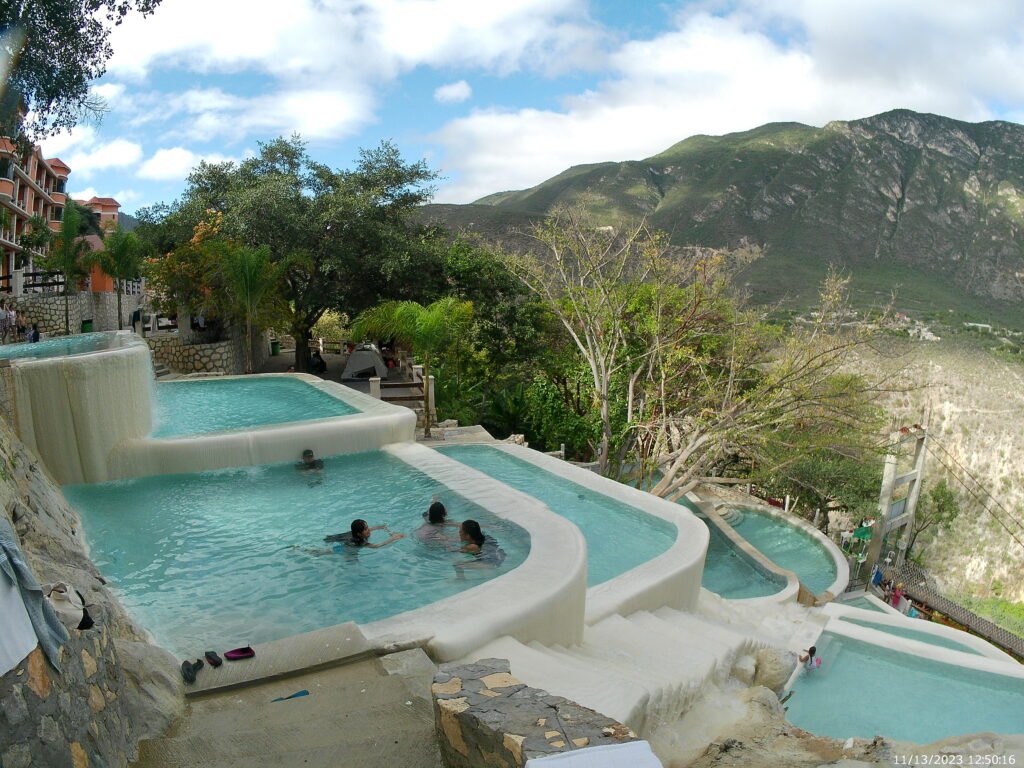
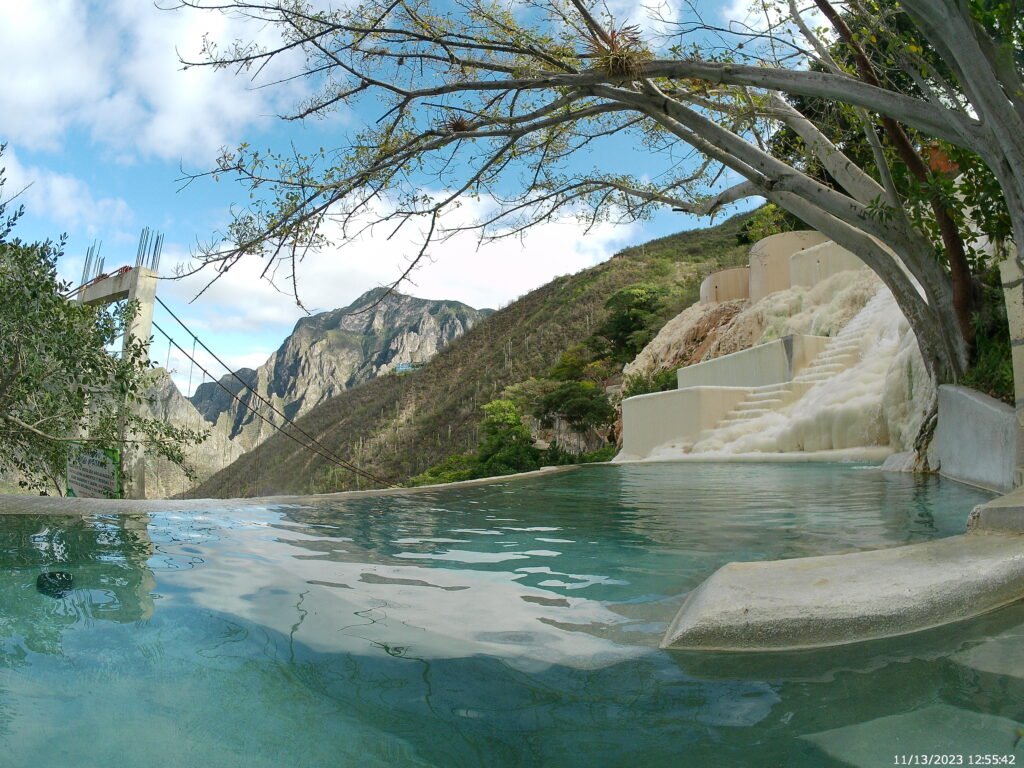
Where to Stay:
There are a variety of full-service hotels within Grutas Tolantongo park. The most economical rooms start at 1000MXN and prices go up from there. Note some of the hotels in more secluded areas of the park are only in operation on weekends and Mexican holidays. The “Grutas” section hotels are the closest to the main parking area as well as to the shops and restaurants – if you have a lot of luggage or have accessibility issues, this may be the most convenient section of the park to stay. If you prefer to be close to the thermal pools area of the park then consider staying in the “Paraiso Escondido” section of the park instead, you can pay an extra fee for a shuttle to drive you to the Paraiso Escondido section from the main parking lot at the Grutas section, or it takes about 45minutes to walk. Note the “Paraiso Escondidos” section is set quite far away from the thermal river, so the trade-off for being close to the thermal pools is that you’ll be further from the river. The opposite is true for the “Grutas” section which is set close to the river, but further away from the thermal pools.
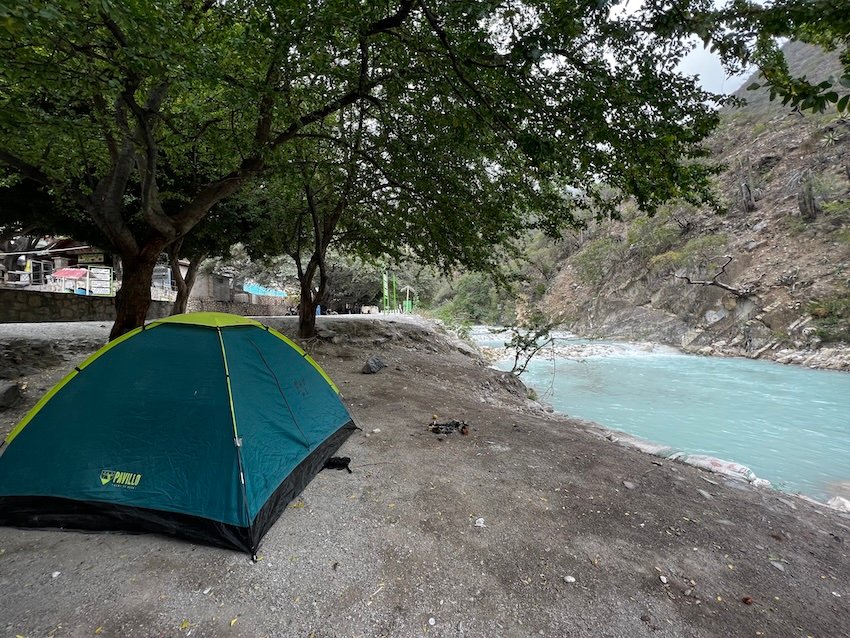
Camping:
In my opinion, the best accommodations option at Grutas Tolantongo is camping under stars next to the river. It is also the most economical option. I came to Tolantogo undecided on whether I was going to camp or take a room. The camping area is right next to the hotspring river – which is amazing. However, I was somewhat concerned about camping by myself in Mexico. When the bus arrived, it took me about 5 seconds to make up my mind: I was going to camp. Tolantogo is still relatively untrodden by international tourists – but it is very popular among local travellers. As I had arrived on a Sunday, there was a zoo of vans and buses in the parking lot – and a lot of people – most are day-trippers. Lots of security and staff around – there is no problem for a single woman camping alone.
Tent rentals are $250MXN per night. I brought my ultralight blow-up sleeping pad, and summer sleeping bag so I was set with just the tent rental. You could also arrive with no camping equipment and rent a pad and blankets as well – but that really starts to add up to being almost equivalent to renting a room (roughly $1000MXN). There are multiple washroom and shower areas that campers can use – everything clean and in good working order.
I recommend camping in and around the “Grutas” section of the park as here you can camp right along the riverside. The busier camping areas will be the area of the river closet to the parking lot, shops and restaurant. However, if you prefer a quieter camping experience, you can simply walk along the river until you find a more secluded spot away from the hotel and restaurant areas.
I found a spot under a tree – right next to the hotspring river and after putting all my money, valuables and passport in not one, but two watertight bags, I waded into the stunning warm aquamarine waters of the hotsprings river. Tolantogo seemed pretty safe – but I would not recommend leaving valuables in a tent. The warm water is perfect. I didn’t bring a thermometer, but the water just by the main camping area I would I put at around 33 – 35 degrees celsius (91F – 95F). When I was there in November, the temperature was slighty on the chilly side around 18 – 20 degrees, so the combination of the cooler temperature and warmer water temperature was perfect.
Due to the daytrippers not having left yet, there were more people than I would have I preferred in the river; so I got out, and walked over to the Tolantogo Caves. The river runs through the Tolantogo Cave system. If you walk along the river to the west of the main camping area, you’ll come across an incredible thermal waterfall which actually cascades overtop a cave that the thermal river meanders into. You can actually enter the cave from the river, and inside there’s a large stalagmite with water pouring out of it which is literally like taking a hot spring shower with excellent water pressure if you stand underneath it. One cave was 40 meters deep and the deeper you walked inside the cave the warmer it became. I marvelled that I was in a hot springs cave at some point, while enjoying the sauna-like experience of being at the end of the cave relaxing in warm thermal waters.
Restaurants and Shops:
There are quite a few restaurants in various areas both the Grutas and Paraiso sections of the park – so there’s no need to pack food. I found prices to be reasonable – considering how remote we were. There was a range of different restaurants you can choose from ranging from economical to more upscale. There are also shops that sell drinks, alcohol and snacks (at a premium). Although it is technically not permitted to bring in outside alcohol to the park, no one was really checking. Mexican families would roll in with enormous coolers full of booze, and didn’t seem to encounter any problems, so I’m guessing the no outside alcohol rule is more of a “suggestion”.
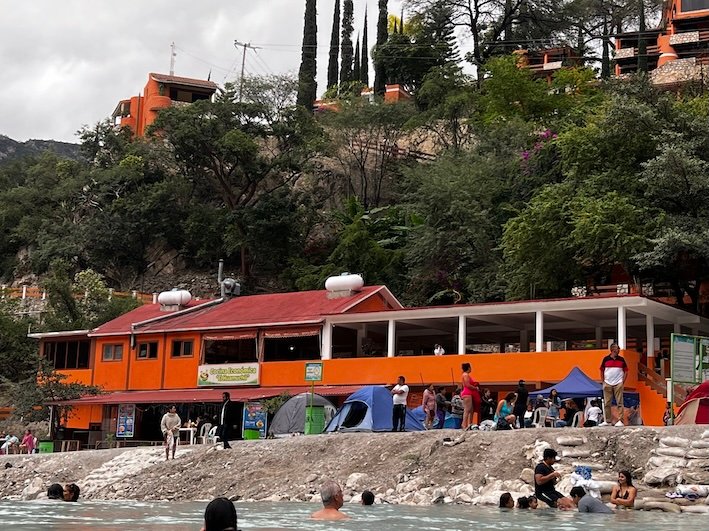
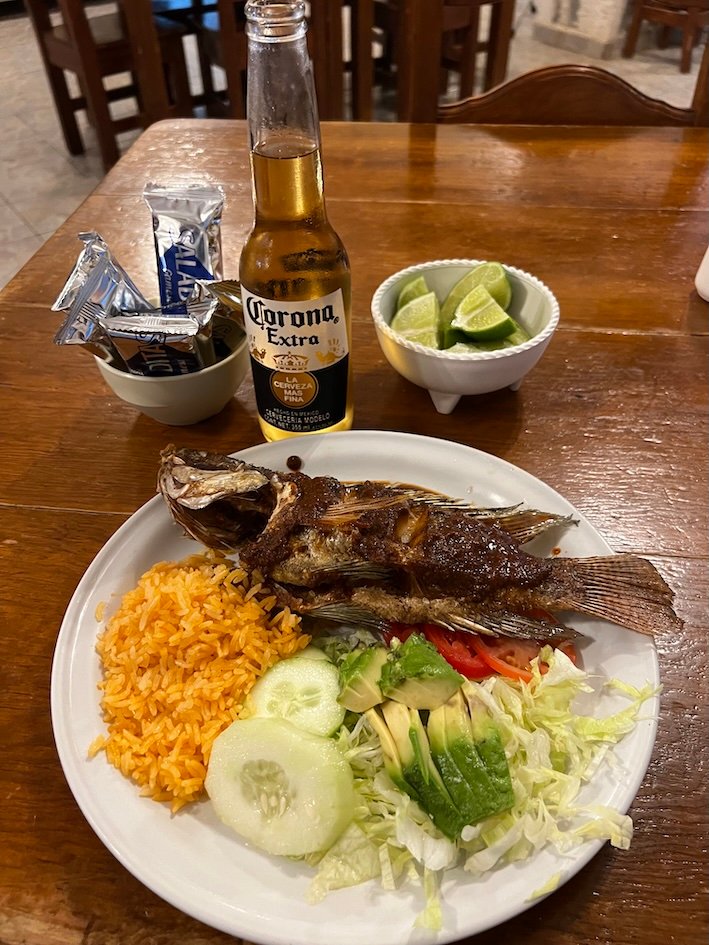
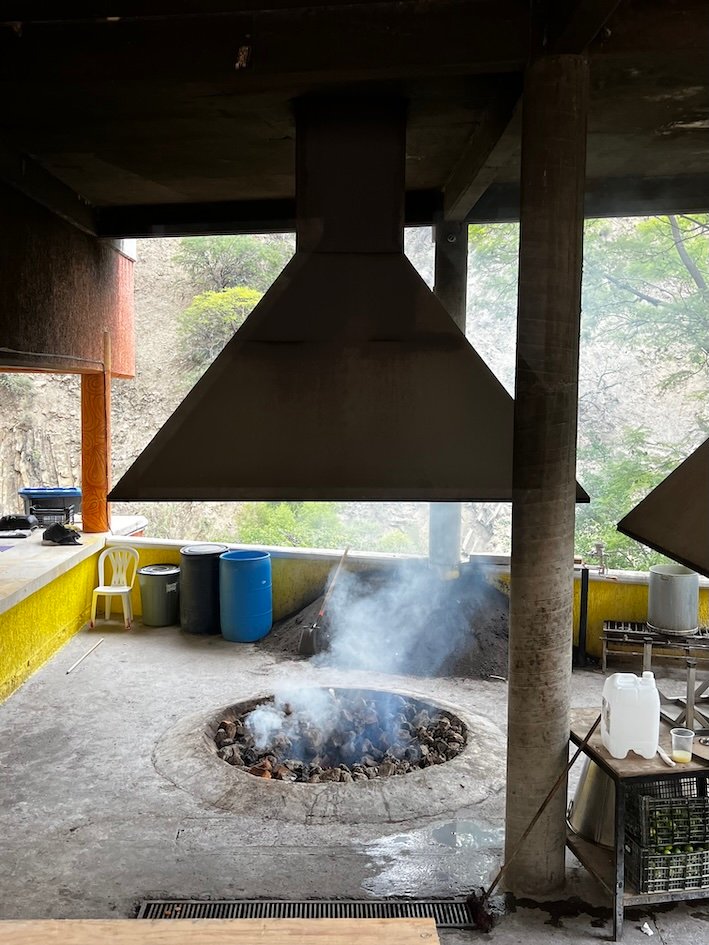
Recommended Packing List:
- Watershoes or Tevas (very important to wear these when you are getting into the river and exploring caves)
- Bathing suit
- Lightweight Towel
- Sarong/Lightweight Beach towel
- Waterproof phone case – for iPhone / for Android (allows for full phone functionality while being 100% waterproof) – very helpful when exploring caves to be able to take photos and use the flashlight, as well as reading e-books while relaxing in the hotsprings
- Cash – everything is paid in cash – including hotel stays – so make sure you bring enough!
- Waterproof pouches for valuables – this is particularly important for camping as I would not recommend leaving valuables like your passport and cash in a tent: I bought this set for my trip and put things like passport and cash into one pouch, and then put that pouch into the waterproof waist-pack for extra security and also to be handsfree while I swam. For nearly the same price, you can also get this set which includes a 10L waterproof backpack which I would recommend.
Additional Packing List if Camping:
- Ultralight sleeping pad
- Lightweight sleeping bag
- Ultralight tent (optional) – but will save you 250MXN per night if you bring one
- Headlamp
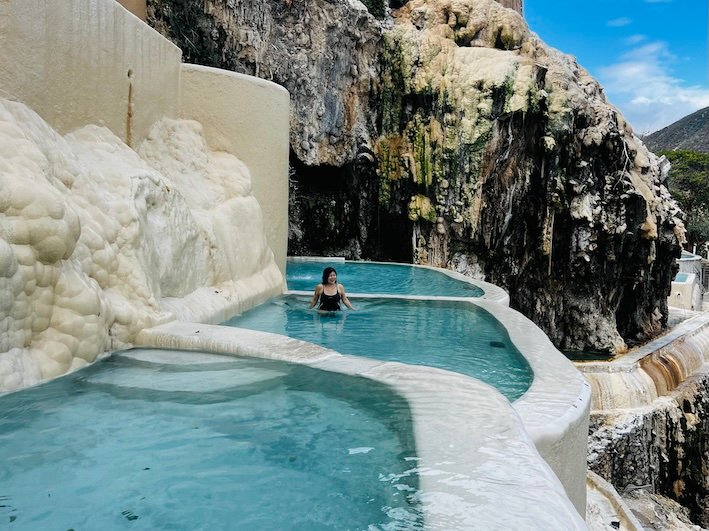
Final thoughts on Grutas Tolantongo:
Grutas Tolantongo is one of the most magical places I have visited on the planet. While its relatively remote location may make it seems daunting to get to Grutas Tolantongo; the journey is well worth it. Whether it’s exploring the incredible natural caves and waterfalls, or floating in the thermal pools that cascade dreamily along the side of a mountain; Grutas Tolantongo lives up to the dreamy images that draw you to this off-the-beaten track location in the first place.
